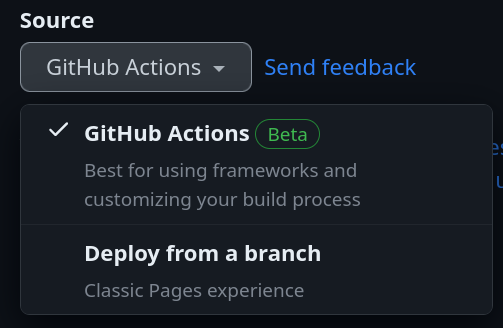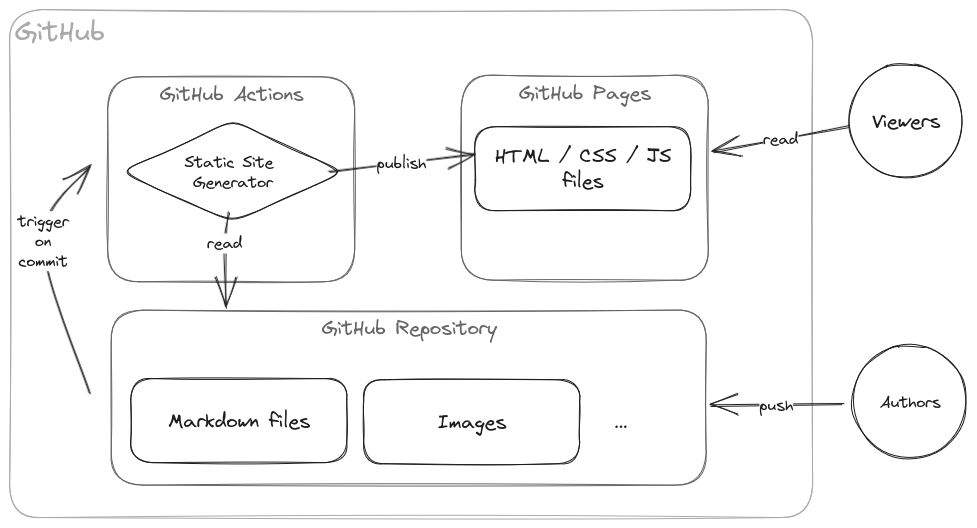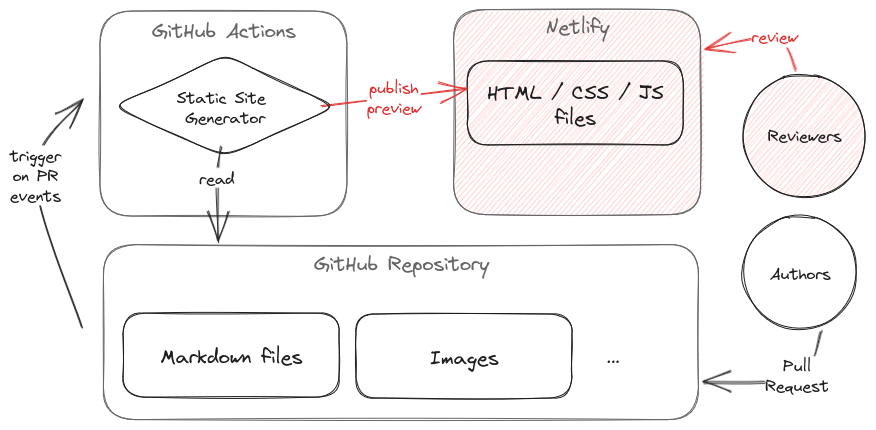I find this approach too heavy-handed, and it doesn’t properly address issues arising from forks. I authored a follow-up for this post, and no longer recommend the method in this post.

The purpose of this post is to review one solution to “how do I provide automated website previews for each Pull Request to my GitHub Pages repository?”
Some services, like ReadTheDocs, provide this workflow out-of-the-box to enable informed reviews to occur without needing to run any command-line tooling. We used ReadTheDocs in my work on QGreenland, and this workflow empowered people who were not comfortable using Sphinx to meaningfully contribute to and review documentation changes. My goal is to replicate that experience in GitHub Pages.

This post assumes you’re using the “GitHub Actions” deployment method, not “Deploy from a branch”. The latter has some well-known pre-packaged solutions, but the former currently doesn’t.
An update should go here when an out-of-the-box solution to this problem becomes available.
My requirements for solving this problem are:
- Free: Some of my work is on open-source projects that won’t ever bring in money.
- Integrates with GitHub: I’d prefer for GitHub Pages to have full support for this out of the box. This is not currently the case (yet), so I need to compromise.
- Minimal/no permissions: If I can’t do this in GitHub’s ecosystem, I don’t want to grant any sort of third-party write permissions to my repository.
📖 GitHub Pages background
If you’re familiar with GitHub Pages, you may want to skip this section.
GitHub provides many free features to open-source projects on its platform. This includes GitHub Pages, a service for hosting “static” (HTML, CSS, Javascript) websites. In combination with open-source software and other GitHub services, you can achieve a comparable authoring experience to “dynamic” content management systems like WordPress. In addition, you get the benefits of open collaboaration on GitHub.

Why not “Deploy from a branch”?
“Deploy from a branch” requires a branch, typically named gh-pages, to contain the final HTML/CSS/Javascript website content that will be hosted on GitHub Pages. I don’t like that option because I don’t feel that non-source materials belong in my repository. I would feel the same about including a compiled binary in my source repository; there are better places for that to live. Additionally, there are security implications to allowing people who fork your repository to deploy code directly into a branch of your repository. Even if you are using “Deploy from a branch”, you may want to consider using a third-party service for PR previews.
Deploying with the “GitHub Actions” method enables me to deploy the output of my build process by uploading it to GitHub as an “artifact”. This atomic deployment method makes pull request previews more challenging, but GitHub is working on it.
Here’s what a GitHub Actions configuration for this method might look like:
name: "Build and deploy"
on:
push:
branches: ["main"]
permissions:
contents: "read"
pages: "write"
id-token: "write"
jobs:
build:
runs-on: "ubuntu-latest"
steps:
- name: "Checkout"
uses: "actions/checkout@v3"
# ... build your site to e.g. `./_site` ...
- name: "Upload site artifact"
uses: "actions/upload-pages-artifact@v1"
with:
path: "./_site"
deploy:
runs-on: "ubuntu-latest"
needs: "build"
environment:
name: "github-pages"
url: "${{ steps.deployment.outputs.page_url }}"
steps:
- name: "Deploy to GitHub Pages"
id: "deployment"
uses: "actions/deploy-pages@v1"This only handles deployments to a live production site. Let’s look at previews for Pull Requests next.
🔍 Achieving Pull Request previews
While GitHub Pages doesn’t yet support Pull Request previews, I still want to use GitHub Pages for my live site. The workflow shown in Figure 1 will be used when PRs are merged or when commits are pushed to the main branch.
For the PR previews, I’ll temporarily use a third-party free service: Netlify.

Why Netlify?
It was the first thing I tried 😁 Their free “starter” plan has the features I need and doesn’t require me to provide a method of payment as of this writing.
Vercel is a viable replacement. I’m sure there are others! If you feel other services should be mentioned here, feel free to open a pull request.
Netlify configuration
To configure Netlify to host my Pull Request previews, I needed to go outside of their “happy path” for setting up a new site. I think Netlify wants people to run their builds on the Netlify build system, but I want to use GitHub Actions.
Since I only use Netlify to host PR previews, I can simply create a blank “Hello world” site, and use deploy previews for PRs.
- Log in with GitHub account, or any other method.
- Skip any prompts to auto-configure a new site, and go to the Netlify dashboard. I don’t want to allow Netlify to install a third-party GitHub app, because it requires too many permissions!
- Create a new site “without connecting to Git”:
Create a mock site, for example:
mkdir /tmp/netlify-site echo "Hello world" > /tmp/netlify-site/index.htmlIn the Netlify dashboard, select the option to upload a folder:

Netlify’s interface to deploy “without connecting to Git” Browse to and upload the mock site saved at
/tmp/netlify-site.Netlify will create a site with a name like verdant-blini-a8c2ad.
- Get the
Site IDfrom the “Site configuration” menu, and save it as a repo secret calledNETLIFY_SITE_ID. - Generate a “Personal Access Token” in user settings, and save it as a second repo secret called
NETLIFY_AUTH_TOKEN.
GitHub Actions configuration
I’m using nwtgck/actions-netlify to push the build as a deploy preview on Netlify.
The GitHub Action workflow requires an extra permission to add comments to PRs like the one seen at the top of this post:
permissions:
pull-requests: "write"Here’s the configuration all together (and if you want, view my live implementation which uses Quarto to build this website, or view the PR that introduced this feature):
# Build, and deploy to either GitHub Pages (production), or Netlify (PR previews)
name: "Build and deploy"
on:
# "Production" deployments are from main branch
push:
branches: ["main"]
# Preview deployments are from on PRs
pull_request:
permissions:
# For GitHub Pages:
contents: "read"
pages: "write"
id-token: "write"
# For PR preview comments:
pull-requests: "write"
jobs:
build:
runs-on: "ubuntu-latest"
steps:
- name: "Checkout"
uses: "actions/checkout@v3"
# ... build your site to e.g. `./_site` ...
- name: "Upload site artifact"
uses: "actions/upload-pages-artifact@v1"
with:
path: "./_site"
# Deploy preview to Netlify IFF this action triggered by PR
# Based on: https://github.com/quarto-dev/quarto-web/blob/main/.github/workflows/preview.yml
deploy_preview:
if: "github.event_name == 'pull_request'"
runs-on: "ubuntu-latest"
needs: "build"
steps:
- name: "Download site artifact"
uses: "actions/download-artifact@v3"
with:
# The name of artifacts created by `actions/upload-pages-artifact` is always "github-pages"
name: "github-pages"
path: "./_site"
- name: "Untar site artifact"
run: "tar --directory ./_site -xvf ./_site/artifact.tar "
- name: "Deploy preview to Netlify"
uses: "nwtgck/actions-netlify@v2"
env:
NETLIFY_SITE_ID: "${{ secrets.NETLIFY_SITE_ID }}"
NETLIFY_AUTH_TOKEN: "${{ secrets.NETLIFY_AUTH_TOKEN }}"
with:
publish-dir: "./_site"
production-deploy: false
github-token: "${{ secrets.GITHUB_TOKEN }}"
deploy-message: "Deploy from GHA: ${{ github.event.pull_request.title }}"
alias: "pr-${{ github.event.pull_request.number }}-preview"
# these all default to 'true'
enable-pull-request-comment: true
enable-commit-comment: false
enable-commit-status: true
overwrites-pull-request-comment: false
timeout-minutes: 1
# Deploy to GH Pages IFF this action triggered by push
deploy:
if: "github.event_name == 'push'"
runs-on: "ubuntu-latest"
needs: "build"
environment:
name: "github-pages"
url: "${{ steps.deployment.outputs.page_url }}"
steps:
- name: "Deploy to GitHub Pages"
id: "deployment"
uses: "actions/deploy-pages@v1"How does this work for open-source teams?
This setup relies on an individual’s Netlify account. This is because Netlify starts to ask for money for team features.
What happens if the person with the Netlify account disappears from the project?
As long as you have other repository admins, or can fork the repository to a new home, you can always have another individual repeat the Netlify configuration steps and replace the NETLIFY_SITE_ID and NETLIFY_AUTH_TOKEN repository secrets with their own.
I hope to only use this solution as a temporary stop-gap until GitHub Pages can more properly support this need.
Going further
I think this pattern could be used to deploy PR previews for multiple GitHub repositories on the same Netlify “site” by including the repo name in the alias option to the nwtgck/actions-netlify action. I haven’t tried it, but maybe it looks like:
alias: "${{github.event.repository.name}}-pr-${{ github.event.pull_request.number}}-preview"🏆 Acknowledgements
- Thanks to reviewers: Wei Ji, Robin Fisher
- Thanks to developers of the actions I relied on.
- This configuration was based on the Quarto website project.
Citation
@online{fisher2023,
author = {Fisher, Matt},
title = {Deploy Pull Request Previews for {GitHub} {Pages}
Repositories (Part 1)},
date = {2023-07-22},
url = {https://mfisher87.github.io/posts/website-repo-pr-preview/},
langid = {en}
}